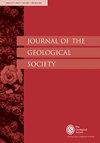缅甸印缅山脉的年代、沉积史和构造
IF 3
3区 地球科学
Q2 GEOSCIENCES, MULTIDISCIPLINARY
引用次数: 1
摘要
印缅山脉(IMR)是一条神秘的山脉带,它占据了缅甸西部一个复杂的构造带,从活跃的巽他-安达曼弧的北部延伸到喜马拉雅构造合的东部。IMR是一个增生的弧前盆地-弧复合体的一部分,该复合体包括缅甸中部盆地和东部的wunho - popa弧。提出了新的生物地层、岩石学和碎屑锆石U-Pb年龄数据,用于测试和完善缅甸西部的发散构造模型。这些资料表明:1)上三叠统Pane Chaung组最初沉积于晚三叠世冈瓦纳北部的东北印度大陆边缘附近;2)IBR的上白垩统-古近系岩石主要来自wunho - popa弧和Inner Belt,次级输入来自地壳源,可能来自纳加变质型古生界基底。Kalemyo蛇绿岩的早白垩世年龄与印度河雅鲁藏布河缝合带、西藏南部和那加兰邦的蛇绿岩年龄相似,这加强了它们曾经是新特提斯海底的一部分的假设。补充资料:https://doi.org/10.6084/m9.figshare.c.6487105本文章由计算机程序翻译,如有差异,请以英文原文为准。
Age, depositional history and tectonics of the Indo-Myanmar Ranges, Myanmar
The Indo-Myanmar Ranges (IMR) are an enigmatic mountain belt that occupy a complex tectonic zone in western Myanmar extending from the northern continuation of the active Sunda-Andaman arc into the eastern Himalayan syntaxis. The IMR are part of an accretionary fore-arc basin-arc complex that includes the Central Myanmar Basin and the Wuntho-Popa Arc to the east. New biostratigraphic, petrologic, and detrital zircon U-Pb age data are presented that are used to test and refine the divergent tectonic models that have been proposed for western Myanmar. These data suggest: 1) that the Upper Triassic Pane Chaung Formation was originally deposited adjacent to the NE Indian continental margin within northern Gondwana during the Late Triassic, and 2) that the Upper Cretaceous – Paleogene rocks of the IBR were mainly derived from the Wuntho-Popa Arc and Inner Belt, with a subordinate input from a crustal source, potentially from the Naga metamorphic-type Paleozoic basement. The Kalemyo ophiolite has an Early Cretaceous age similar to ages of ophiolites in the Indus Yarlung-Tsangpo suture zone, south Tibet and Nagaland, reinforcing the hypothesis that they were once part of the same Neo-Tethyan ocean floor.
Supplementary material:
https://doi.org/10.6084/m9.figshare.c.6487105
求助全文
通过发布文献求助,成功后即可免费获取论文全文。
去求助
来源期刊

Journal of the Geological Society
地学-地球科学综合
CiteScore
6.00
自引率
3.70%
发文量
68
审稿时长
6-12 weeks
期刊介绍:
Journal of the Geological Society (JGS) is owned and published by the Geological Society of London.
JGS publishes topical, high-quality recent research across the full range of Earth Sciences. Papers are interdisciplinary in nature and emphasize the development of an understanding of fundamental geological processes. Broad interest articles that refer to regional studies, but which extend beyond their geographical context are also welcomed.
Each year JGS presents the ‘JGS Early Career Award'' for papers published in the journal, which rewards the writing of well-written, exciting papers from early career geologists.
The journal publishes research and invited review articles, discussion papers and thematic sets.
 求助内容:
求助内容: 应助结果提醒方式:
应助结果提醒方式:


